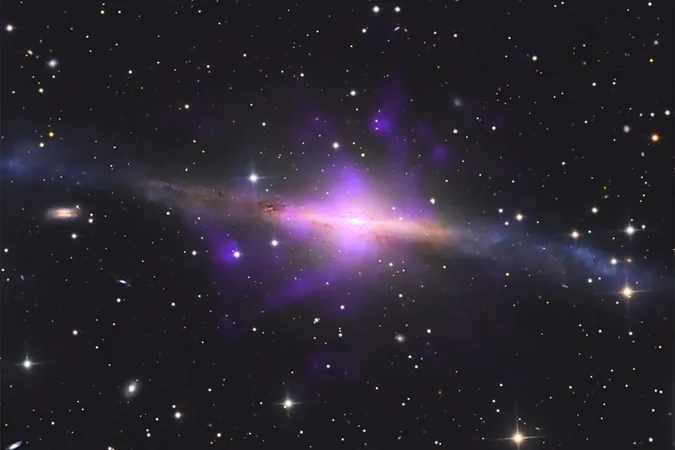
Shocking Discovery! Astronomers Uncover a 'Sideways' Supermassive Black Hole in Galaxy NGC 5084
2024-12-21
Author: Siti
Introduction
Astronomers have made a groundbreaking discovery in the study of galaxy NGC 5084, revealing that a supermassive black hole at its center is positioned at an astonishing tilt, lying on its side. This unusual orientation presents a new mystery in cosmic research that could reshape our understanding of black hole behavior.
Background on NGC 5084
NGC 5084 isn't new to astronomers; however, a recent analysis of archival data combined with innovative investigative techniques exposed the peculiar positioning of its supermassive black hole. Utilizing advanced methodologies developed at NASA’s Ames Research Center, the research team scrutinized data from the Chandra X-ray Observatory, leading to the detection of remarkable features previously overlooked.
A Tale of Plasma and X-rays
The findings include the existence of four extensive plumes composed of hot, charged gas, known as plasma, that ejected from the black hole into the surrounding space. Of these, one pair extends vertically above and below the galaxy’s plane, while the other pair forms a striking 'X' shape within the galactic plane itself. The presence of such a configuration, with two pairs of plumes, is unprecedented in galactic studies, as most galaxies typically feature only one or two plumes.
The lead investigator, Ames research scientist Alejandro Serrano Borlaff, employed a novel technique aimed at detecting low-brightness X-ray emissions, leading to compelling new insights into NGC 5084. By delving deeper into archival data from leading observatories like the Hubble Space Telescope and the Atacama Large Millimeter/submillimeter Array (ALMA) in Chile, the team was able to identify a small dusty disk at the galaxy's center that further supports the existence of a supermassive black hole.
The Twisted Mystery
What is truly astonishing, however, is the revelation that this supermassive black hole is rotating at a 90° angle compared to the rotation of NGC 5084 itself, leading to its 'tipped over' orientation. Serrano Borlaff describes this discovery as akin to piecing together a crime scene with various types of evidence: 'Putting all the pictures together revealed that NGC 5084 has changed a lot in its recent past.'
The implications of this tilted black hole are profound. Astrophysicist Pamela Marcum emphasizes that detecting two pairs of X-ray plumes in a single galaxy is a rare phenomenon, presenting unique insights into its astronomical history. The abnormal structure of the plumes, combined with the dusty disk's orientation, prompts speculation about the dynamic processes at play within this galaxy.
What Could Have Caused the Tilt?
Researchers are left to ponder the forces behind this cosmic anomaly. Potential explanations include interactions with another galaxy or the catastrophic effects of superheated gas creating a ‘chimney’ effect, both of which could have significantly impacted NGC 5084's structure and the black hole’s position.
Conclusion
The innovative techniques applied in this study are proving indispensable as they delve deeper into archival data, leading to new cosmic mysteries waiting to be unraveled. This transformative research is set to be published in the forthcoming issue of The Astrophysical Journal, offering the scientific community a profound new chapter in the understanding of black holes and galaxy dynamics.
Stay tuned as we follow the developments surrounding this fascinating discovery that not only challenges existing theories but also opens exciting avenues for further inquiry into the mysteries of our universe!



 Brasil (PT)
Brasil (PT)
 Canada (EN)
Canada (EN)
 Chile (ES)
Chile (ES)
 España (ES)
España (ES)
 France (FR)
France (FR)
 Hong Kong (EN)
Hong Kong (EN)
 Italia (IT)
Italia (IT)
 日本 (JA)
日本 (JA)
 Magyarország (HU)
Magyarország (HU)
 Norge (NO)
Norge (NO)
 Polska (PL)
Polska (PL)
 Schweiz (DE)
Schweiz (DE)
 Singapore (EN)
Singapore (EN)
 Sverige (SV)
Sverige (SV)
 Suomi (FI)
Suomi (FI)
 Türkiye (TR)
Türkiye (TR)